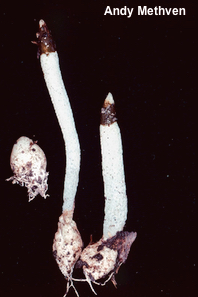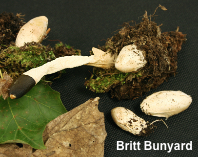| Major Groups > Stinkhorns > Mutinus caninus albus |

|
[ Basidiomycota > Phallales > Phallaceae > Mutinus . . . ] Mutinus caninus albus by Michael Kuo, 28 August 2025 This rare stinkhorn is kind of like an albino Mutinus. Like other species in the genus, it consists of a stem-like structure with no separated cap or head structure; spore slime is distributed across the surface of the stem itself. Mutinus caninus variety albus can be separated on the basis of its white stem and "eggs"; other North American Mutinus species have orange, red, or pink stems. Rarely, white-stemmed forms of Phallus rugulosus are found (see the linked page for an illustration), but that species is only superficially similar; close examination reveals a structurally separated head. It is unlikely that Mutinus caninus var. albus is actually a taxonomic "variety" of the orange-stemmed European species Mutinus caninus, although it may be closely related. Thorough study of many well-documented collections may eventually resolve the issue. Brazil's Mutinus albotruncatus is similarly colored but features an abruptly truncated, cylindric apex and a proportionally longer zone of spore slime. It appears on decaying wood, and is not recorded from North America. Description: Ecology: Saprobic; growing alone or gregariously in gardens and cultivated areas, or in woods; summer and fall; originally described from Oregon; also distributed in the upper Midwest, from Minnesota to Michigan. The illustrated and described collections are from Michigan and Wisconsin. Immature Fruiting Body: A whitish "egg" 2–3 cm high and 1.5–2 cm wide; surface smooth; when sliced revealing the stinkhorn-to-be encased in a gelatinous substance. Mature Fruiting Body: 6–10 cm high; 8–15 mm thick at widest point; cylindric, with an abruptly tapered apex; hollow; surface spongy, granular and wrinkled when young, becoming pocked, whitish to faintly yellowish; apex sterile and becoming perforated at maturity; when fresh covered with brown to olive brown spore slime in an apical zone, sometimes with a sharply delimited lower limit; base encased in a white to yellowish, sacklike volva; attached to thin white rhizomorphs. Odor: Foul and strong while the spore slime is present. Microscopic Features: Spores 3–4 x 1.5–2 µm; cylindric; smooth; hyaline in KOH. Sphaerocysts of the pseudostipe 20–50 µm across; irregularly subglobose; walls 0.5–1 µm thick; smooth; hyaline in KOH. Hyphae of the volva cylindric; 4–7 µm wide; smooth; hyaline in KOH. Clamp connections not found. REFERENCES: S. M. Zeller, 1944. (Lloyd, 1909; Zeller, 1944; Smith, 1951; da Silva et al., 2015.) Herb. Mich 6654 (AHS 25702). Herb F. PRL 11005. This site contains no information about the edibility or toxicity of mushrooms. |
|
Cite this page as: Kuo, M. (2025, August). Mutinus caninus albus. Retrieved from the MushroomExpert.Com Web site: http://www.mushroomexpert.com/mutinus_caninus_albus.html © MushroomExpert.Com |

